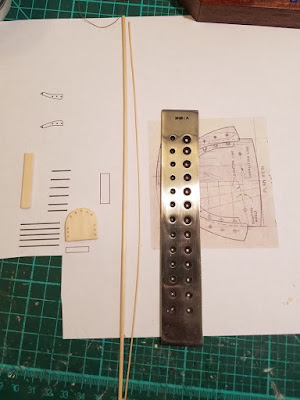Apologies
for not having posted for a while. I flew
to Arizona to visit my mother for a week and came down with a cold. 🤧
Although it was
a mild cold, I still had it the weekend of the Good Sam Show, which I really
felt that I shouldn't attend under the circumstances. 😢 I spent most of the weekend just resting. Last week, I was in training all week,
learning Java coding for one of the applications I support. Between recovering from my cold and straining
my brain on all that coding, I was pretty exhausted every night, which meant
that I really had no energy to work on the library. This past weekend, though, I finally got to make
something. Yay!
The library has a Windsor chair.
I
had originally intended to purchase one here: https://www.mastersminiatures.com/54-windsor-armchair-121-p.asp,
but I feel like I've kind of been on a roll making my own pieces and thought
I'd at least like to try to make one
myself.
My
biggest concern was how to get dowels small enough. The smallest I could find online were
1/16" in diameter, and those were just way too thick for half scale. I thought I would have to buy a lathe, and was
blanching at the price, but, on a model ship building Web site, I found out
that the best way to make super-skinny dowels was with a jeweler's draw plate,
which I promptly ordered. Basically,
what you do is take your 1/16" dowel and keep pulling it through
successfully smaller holes on the draw plate.
As you do that, the dowel gets shaved down more and more until it's the
size you need. I found that I had to
pull the dowel through each hole several times, and it helped to pull from end
for a while, then switch to pulling from the other end. Here you can see how I was able to really
shave down my dowel! The one on the left
is what I started with; the one on the right is what I ended up with. The
process is actually kind of fun and Zen, but you do get little wood shavings everywhere. 😊
I cut the arms, back and seat from bass wood, and used my little pin vise to drill the holes I needed. I had to go fairly thick on the chair back, as I needed to be able to drill holes in the edge of the wood. The dowels did not take stain well, so I ended up using my India ink pens to try to color them to look like my mahogany stain.
On
my first try, the dowels looked too skinny to me (although looking at the
original chair, they were probably fine).
So
I tried again, going a little thicker with my dowels. I also made even thicker dowels for the legs
and did a little carving on the ends, using the same techniques I used on the
barley-stick table legs. It was fiddly
as all heck trying to get all the dowels inserted into their correct holes and
relatively straight. That was definitely
the hardest part of making it and accounted for the most use of
"magic" words. The outer back
dowels must go all the way through the arm rests, and, as you can see on try
one, I had difficulty getting the arm rests even.
Here
is the little chair I ended up with, next to a match box. I am actually pretty
happy with it, although I know it's not an exact match for the one Theodore
Roosevelt had. Below is a picture of it
in the room.













